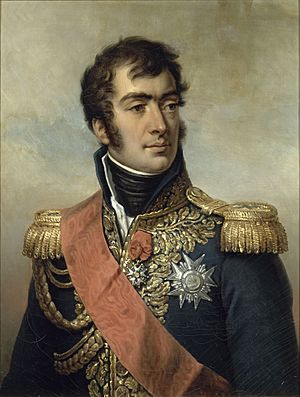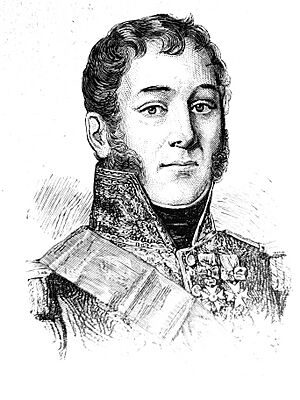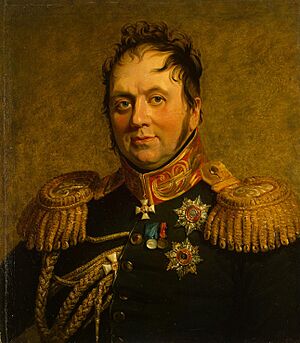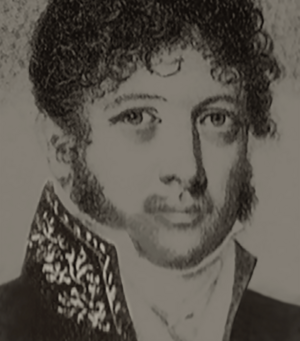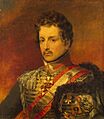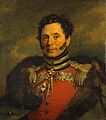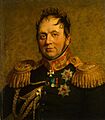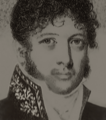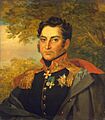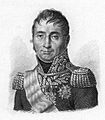Battle of Fère-Champenoise facts for kids
Quick facts for kids Battle of Fère-Champenoise |
|||||||
|---|---|---|---|---|---|---|---|
| Part of the Campaign of France of the Sixth Coalition | |||||||
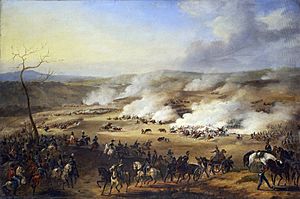 The Battle of Fère-Champenoise |
|||||||
|
|||||||
| Belligerents | |||||||
| Commanders and leaders | |||||||
| Strength | |||||||
| 26,400-28,000 128 guns 180,000 reinforcements |
16,600-21,000 84 guns |
||||||
| Casualties and losses | |||||||
| 2,000-4,000 | 10,000-13,000 60-80 guns lost 225-250 wagons captured |
||||||
The Battle of Fère-Champenoise happened on March 25, 1814. It was a big fight during the War of the Sixth Coalition. Two French armies, led by Auguste de Marmont and Édouard Mortier, duc de Trévise, faced a much larger group of armies. These armies were from Austria, Prussia, Württemberg, and Russia.
The French forces were surprised by the main Coalition army. They were pushed back and eventually defeated by the strong Allied cavalry and cannons. The French lost many soldiers and most of their artillery. Two groups of French soldiers, called National Guards, were also attacked. They were protecting a nearby convoy and were almost completely wiped out. This part of the battle is sometimes called the Battle of Bannes. The fighting took place near the town of Fère-Champenoise in France.
After Napoleon lost the Battle of Arcis-sur-Aube, he moved his army east. He hoped to make the Coalition armies follow him, moving them away from Paris. But the main Coalition army, led by Karl Philipp, Prince of Schwarzenberg, decided to march directly towards Paris instead. Meanwhile, Marmont and Mortier were trying to join Napoleon. They were being chased by another Allied army led by Gebhard Leberecht von Blücher.
As Marmont and Mortier moved east, they suddenly ran into Schwarzenberg's army coming west. Blücher's army was also moving south. The French realized they were caught in a trap and began to retreat west. After six hours of organized retreat, a sudden heavy rainstorm hit. This made it hard for the French soldiers to fire their guns. The Allies had many more cavalry, which became a huge advantage. With Marmont and Mortier's armies badly damaged, the Allies were almost certain to capture Paris. The Battle of Paris happened soon after, on March 30.
Contents
Background to the Battle
Napoleon's Strategy
In March 1814, Gebhard Leberecht von Blücher's large Coalition army defeated Napoleon's smaller army at the Battle of Laon. After this loss, Napoleon attacked a Russian and Prussian force at the Battle of Reims. He won this battle, causing the Allies to lose many men and cannons.
Napoleon then left Auguste de Marmont and Édouard Mortier, duc de Trévise with about 21,000 soldiers. Their job was to watch Blücher's army. Napoleon himself tried to outsmart Karl Philipp, Prince of Schwarzenberg's main army. He moved towards Arcis-sur-Aube.
On March 20, Napoleon's army fought a tough battle at Arcis-sur-Aube. His 28,000 soldiers faced 80,000 Allies. Napoleon managed to pull his army back safely, but the battle was a Coalition victory. After this, Napoleon decided to attack the Allied supply lines. He moved northeast, hoping to trick the Allies into following him away from Paris.
Marmont and Mortier's Movements
Blücher's army started moving again on March 18. Marmont was in charge of the French forces facing Blücher. His orders were to protect Paris and stop the Allies from crossing the Aisne River. Blücher had many more soldiers than Marmont. So, Marmont and Mortier had to fall back southwest.
Blücher sent some of his troops to follow Marmont. On March 21, Marmont and Mortier crossed the Marne River at Château-Thierry and destroyed the bridge. Napoleon sent a message telling Marmont to move back towards Châlons-sur-Marne. So, on March 22, the two French marshals headed east.
By the evening of March 23, Marmont's troops were in Vertus and Mortier's were in Étoges. A French officer found some enemy messages that hinted the two big Allied armies might join up and march on Paris. But the French marshals thought these messages were a trick and ignored them.
Meanwhile, two French divisions, led by Michel-Marie Pacthod and François Pierre Joseph Amey, were at Sézanne. They found a large convoy of food and equipment there. They decided to take the convoy and join Marmont and Mortier.
On March 23, the Allies learned that Napoleon was at Saint-Dizier. They decided to combine their two huge armies and go after Napoleon with 200,000 soldiers. However, Czar Alexander I of Russia had a different idea. After seeing captured messages about Paris, he decided the Allied armies should march directly on Paris. He convinced the other Allied leaders.
So, on March 24, the Allied armies changed their plans. Instead of chasing Napoleon, they began moving west towards Fère-Champenoise.
The Battle Unfolds
French Retreat Under Pressure
On March 24, Marmont and Mortier marched through Fère-Champenoise. Their scouts reported seeing only a few enemy cavalry. Based on this, the marshals thought the main Allied army was still far away. They didn't realize that many enemy campfires were visible nearby that night.
On March 25, at dawn, Allied cavalry patrols began moving. The main Allied advance came in two columns. One column, led by Crown Prince Frederick William of Württemberg and Nikolay Raevsky, moved west. The other column, with the Guard and Reserves, took a more southerly route.
Around 6:00 to 8:00 am, Allied cavalry, led by Peter Pahlen, appeared before the French. Marmont was surprised when Pahlen's cannons started firing. He quickly set up his infantry and artillery and sent a message for Mortier to join him. Pahlen and Prince Adam of Württemberg attacked right away.
The Allies quickly had 10,000 cavalry against only 4,934 French cavalry. Marmont's cavalry, led by Étienne Tardif de Pommeroux de Bordesoulle, was beaten back. Two French companies were surrounded and captured.
Mortier's troops arrived, and the two French armies joined together. They put their cavalry in front and infantry behind. The French had 60 cannons, which were stronger than the Allies' 36 cannons for two hours. But the Allies kept pressing. Marmont began to pull back to a position where streams protected his flanks.
Marmont's Army Overwhelmed
The Allied cavalry charged the French right side, pushing them back. At the same time, other Allied cavalry attacked the French left. The Allies captured five French cannons. As the French retreated, they had to cross a small stream. Just then, a strong storm blew dust, rain, and hail into their faces.
This made it very hard for the French soldiers to fire their wet muskets. The Grand Duke Konstantin led a powerful charge of Russian cavalry. This charge broke the French cavalry, which was already disorganized from crossing the stream. After the French horsemen fled, the Coalition cavalry broke two regiments of French Young Guard infantry. Many French soldiers were killed, and eight cannons were captured.
One French brigade of 1,000 men fought bravely, repelling three cavalry charges while in a square formation. But a fourth charge broke them, causing heavy losses. Russian cannons also fired accurately at the French. Luckily for the French, two divisions held firm, allowing a brief chance to regroup. But then, more Cossacks appeared, causing the remaining French soldiers to panic and run.
The panic spread, and Marmont's entire force retreated. They were saved by a small group of French heavy cavalry that arrived and drove off the chasing Allies. Marmont and Mortier reorganized their damaged armies near Fère-Champenoise. They heard more gunfire and thought Napoleon was coming to help. But it was the Allies attacking another French force. The Allied generals then focused most of their cavalry on this new target. Marmont's troops were pushed off the field and reached Allemant by 9:00 pm.
Pacthod's Brave Stand
The other French force was led by Michel-Marie Pacthod. His troops had marched most of the night with a convoy of supplies. Around 10:00 am, they were attacked by 1,200 Allied dragoons and horse chasseurs with 12 cannons. Pacthod's soldiers formed squares, a defensive formation, and placed 16 cannons in front.
For 90 minutes, the French moved southwest, fighting off the Allied cavalry. At Clamanges, Pacthod decided to leave the convoy behind. He took the horses to help pull his cannons. More Russian cavalry arrived, making the Allied force even larger. Two regiments of horse chasseurs circled around, blocking the French retreat.
Around 2:00 to 3:00 pm, the French reached Écury-le-Repos. More Allied cavalry arrived, including Ilarion Vasilievich Vasilshikov's hussars. They charged the French, forcing them to form squares again. Meanwhile, Schwarzenberg, Czar Alexander, and King Frederick William III arrived on the battlefield.
The Czar ordered the Prussian Guard Cavalry and Russian Guard Hussars to join the fight. He also told the 23rd Horse Battery to fire on Pacthod's men. The Russian cannons pounded Pacthod's squares, causing many casualties. Pacthod's soldiers, who were mostly National Guardsmen, fought bravely. They held their square formations even though they were surrounded by enemy cavalry.
Seventy-eight Russian cannons were now firing at Pacthod's squares. One of Pacthod's brigades fought its way to Bannes but was blocked by elite Russian cavalry. Allied officers came forward to demand Pacthod's surrender. The French general refused to give up while the cannons were firing.
Finally, a massive charge by the Russian cavalry broke the French squares. The French soldiers were either killed or surrendered. Generals Pacthod, Amey, and others became Allied prisoners. Only about 500 of Pacthod's brave National Guardsmen escaped the terrible fight.
Battle Outcomes
The Battle of Fère-Champenoise was a major victory for the Coalition. The French suffered heavy losses. Marmont and Mortier lost about 2,000 killed and wounded. They also had 4,000 soldiers, 45 cannons, and 100 ammunition wagons captured. Pacthod's force was almost completely destroyed, losing about 4,300 men, 16 cannons, and the entire convoy. Only a few hundred of his men escaped. In total, the French lost between 10,000 and 13,000 soldiers and 60 to 80 cannons. The Allies lost between 2,000 and 4,000 soldiers.
After the battle, Marmont and Mortier retreated. They were joined by Jean Dominique Compans and other French soldiers. They tried to reach Paris, but the Allied armies were too strong. On March 26, Napoleon won a small victory against some Allied cavalry at the Battle of Saint-Dizier. But the next day, he finally realized that the Allies were marching directly on Paris. He ordered his troops to rush to the capital, but it was too late.
On March 30, the French army, with about 42,000 men (only 23,000 experienced soldiers), faced the combined Allied armies of 107,000 troops. After the Battle of Paris and the surrender of the capital, Napoleon's empire came to an end.
See also
- Fershampenuaz, a village in Russia named in memory of the battle.
Images for kids



